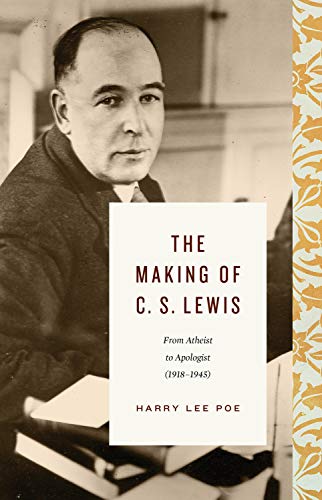From Idealist to Christian: The Conversion of C.S. Lewis
Lewis began to read in a new way. Until this point in his life, he thought of the novel as a “dangerous form” of literature.[1] He thought the novel divided readers into the low-brow type and the high-brow type. The low-brow simply have a “narrative lust” to get to the ending and find out what happens.[2] If the best-loved characters marry, regardless of whatever misery may enshroud the rest of the characters, then it is a happy ending. If the main characters do not marry, no matter how happy the state of all the other characters, then it is an unhappy ending. In reading Tolstoy’s War and Peace, however, he discovered a new kind of writing in which it is possible to remain detached from the main characters. He insisted to Greeves that it was not a blank indifference but almost like “a submission to the will of God.”[3] He would continue to think about low-brow and high-brow approaches to reading until he put it all down on paper in An Experiment in Criticism, published in 1961, two years before he died. To think in terms of submission to the will of God, however, meant that he did not have much time left as a mere theist.
Jack had learned the virtues of honest toil at the Kilns, but he also discovered that the Kilns had great pleasures. Once term was ended, he had troves of time to spend lolling in a deck chair, reading, punting, and swimming in his pond. The pond did, and still does, look profoundly dirty, but Jack assured Arthur that he emerged perfectly clean after swimming. Arthur visited Jack for the first time at the Kilns at the end of May 1931, and Warnie was able to join them for a weekend leave. In August, Jack and Warnie returned to Ireland for the first of many visits after they no longer had a home in Belfast. On the visit, Jack’s love of science having revived, he had a long argument with his uncle Gussie Hamilton about the metaphysical implications of Einstein’s theory and the nature of the atom. Warnie, who despised philosophy in any form, managed to change the subject by interjecting, “How are things at the yard, Gussie?”[4]
Warnie returned to his post after touring many of their favorite places in Ulster, but he left Jack in Ireland where he spent a week with Greeves at his family’s house across from Little Lea. Arthur sent him back to Oxford with volumes of Thomas Hooker and Jeremy Taylor, two of the great theologians of the seventeenth century. Jack was reading Hooker in September 1931.[5]
On a Saturday night, September 19, Lewis invited Hugo Dyson and Ronald Tolkien to join him for dinner at Magdalen College.[6] Michaelmas term would not begin for a few more weeks, so their dinner conversation would not be overwhelmed by the noise of scores of undergraduates in the hall. Dinner at Magdalen was a grand affair with multiple courses. It was not a rushed meal and could easily last until almost nine o’clock, when the fellows retired to the Senior Common Room to smoke, have their coffee, and perhaps drink port wine. It was a memorable evening full of the kind of talk that Jack enjoyed: metaphor and myth, which had been the focus of much of his disagreement with Barfield. The three men began strolling along Addison’s Walk, a wooded path about a mile in circumference within the grounds of Magdalen College that circles a meadow and is bounded by small waterways, like an island. In the warm mid-September night, a sudden wind came up and scattered the newly fallen leaves, producing a sound like falling rain. It was one of those magical moments in nature that Lewis loved. The men then retreated to Lewis’s rooms to continue their conversation, which turned to Christianity.[7]
On October 1, Jack wrote to Arthur with the news that he had passed “from believing in God to definitely believing in Christ.”[8] Arthur would have to wait for more than two weeks, however, to learn the story of what had happened in that long night of talking.
Almost a month after the evening with Tolkien and Dyson, in one of his again frequent letters to Arthur, Lewis explained what had happened to him in the course of that late-night conversation. For the previous year since his acceptance of the reality of God, Lewis had been struggling to understand what Christianity means. Once you believe in God, then believing that God might take on flesh is not a problem. Lewis’s problem was not believing that it could happen but understanding why God would become man and what difference it would make. He struggled to understand what it means that Jesus died to save the world. Lewis did not see how the death of someone two thousand years ago could have anything to do with him. He had no problem with the necessity of some kind of miraculous salvation, because he had a strong awareness of the flawed nature of people, especially himself, that leads them into degradation incompatible with God. Jesus might help as an example, but Lewis knew that the Gospels and the epistles of Paul describe something quite different from a simple example. Something very mysterious was going on with such phrases as “propitiation,” “sacrifice,” and “the blood of the Lamb.”[9]
In their conversation about myth, Lewis realized that he did not mind the idea of sacrifice when he found it in pagan myths. He gave the example of Odin in The Hávamál, which he had quoted on the page facing the title page of Dymer: “Nine nights I hung upon the Tree, wounded with the spear, as an offering to Odin, myself sacrificed to myself.”[10] In fact, when he found the case of a god sacrificing himself to himself, he liked it very much and thought it mysteriously moving. He also was powerfully moved by the myths of a dying and rising god that he found in so many cultures; such as the story of Balder in Norse mythology, Adonis in Greek mythology, and Bacchus in Roman mythology. To these he might have added Baal of the Canaanites and Osiris of the Egyptians. He realized that he liked these stories anywhere he found them, except in the Gospels.[11] He could enjoy the myths and revel in the feelings they gave him without having to ascribe any particular objective meaning to them. As he had been taught in school, the old myths were just made-up stories. On this account, he had decided that the story of Jesus dying for the world and rising from the dead was just another myth.
In an earlier conversation, T. D. Weldon had made the off- hand remark that the Gospels appeared to be based in fact.[12] The remark had stuck in Lewis’s mind, coming as it did from a virulent atheist. The conversation had taken place in 1926. Yet, in Surprised by Joy, Lewis mentioned it in relation to his move to theism in 1930. Its full impact, however, did not hit him until late September 1931 in his discussion with Tolkien and Dyson about the story of Jesus as a myth like all the others. It struck him as like the other myths, but somehow different. All the others had taken place “once upon a time,” but the story of Jesus unfolded in Palestine shortly after its incorporation into the Roman Empire. Jesus was born the year that a decree went out from Caesar Augustus that the entire Roman world should be taxed, the same year that Quirinius became governor of Syria and Herod was king of Judea. Jesus did not die outside space and time, as things happen in all the other myths; he died on Golgotha Hill outside Jerusalem when Pontius Pilate was governor of Judea and Herod Antipas was tetrarch. Lewis decided that the story of Jesus was the myth that really happened.[13]
Content taken from The Making of C. S. Lewis by Harry Lee Poe, ©2021. Used by permission of Crossway.
Harry Lee Poe (PhD, The Southern Baptist Theological Seminary) serves as the Charles Colson University Professor of Faith and Culture at Union University, where he has taught a course on C. S. Lewis for over fifteen years. He is the author of The Inklings of Oxford and C.S. Lewis Remembered, as well as numerous articles. Poe hosts regular Inklings Weekend retreats and is a speaker on Lewis at major libraries worldwide.
[1] Hooper, Letters, 1:957.
[2] Hooper, Letters, 1:957–58.
[3] Hooper, Letters, 1:958.
[4] Kilby and Mead, Brothers and Friends, 84.
[5] Hooper, Letters, 1:967.
[6] Hooper, Letters, 1:969.
[7] Hooper, Letters, 1:970.
[8] Hooper, Letters, 1:974.
[9] Hooper, Letters, 1:976.
[10] Clive Hamilton [C. S. Lewis], Dymer (New York: E. P. Dutton, 1926), ii.
[11] Hooper, Letters, 1:976–77.
[12] Walter Hooper, ed., All My Road before Me: The Diary of C. S. Lewis, 1922–1927 (New York: Harcourt Brace Jovanovich, 1991), 379; Lewis, Surprised by Joy, 211.
[13] Hooper, Letters, 1:977. In Surprised by Joy, Lewis gave a brief synopsis of his thought about how the story of Jesus differed from myth and history, yet was similar to both. See Lewis, Surprised by Joy, 221–22.

